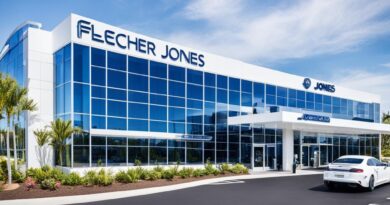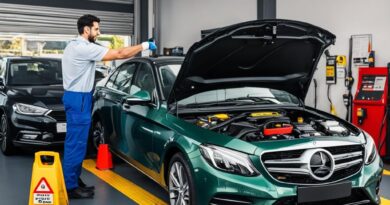Understanding Car Paint Layers Depth
In the world of automotive finishes, car paint layers play a crucial role in protecting and enhancing the appearance of vehicles. The depth and complexity of these layers are key factors in determining the overall quality and longevity of a car’s paint job.
By delving into the composition, function, and thickness of automotive paint systems, we can gain a better understanding of how each layer contributes to the overall performance and aesthetics of the vehicle.
Key Takeaways:
- Car paint layers are essential for protecting and enhancing the appearance of vehicles.
- The depth and complexity of automotive paint systems impact the overall quality and longevity of a car’s paint job.
- Understanding the composition, function, and thickness of each layer helps in making informed decisions about paint care, correction, and protection.
- Proper maintenance and the use of quality paint materials contribute to a long-lasting, attractive finish.
- Choosing the right car paint protection, such as ceramic coatings, can significantly enhance the longevity and appearance of the paint job.
The Composition and Function of Modern Automotive Paint
Most modern automotive paint systems consist of a dual-component paint system, which includes a Base Coat (BC) and a Clear Coat (CC). The base coat provides color, while the clear coat offers protection and a glossy finish. The paint is composed of pigmentation suspended in a resin, usually a solvent-based polyurethane or a water-based acrylic. Polyurethane provides excellent resistance to weather, oxidation, UV radiation, water, and chemicals, as well as superior flexibility, abrasion resistance, and heat tolerance. Additionally, some vehicles still use a single-layer paint system known as single stage (SS) paint.
It is important to understand the composition and function of modern automotive paint as it significantly affects the appearance and longevity of a vehicle’s exterior. The base coat is responsible for delivering the desired color and visual appeal, while the clear coat provides an essential protective layer. By combining these two components, automotive manufacturers create a robust and visually appealing finish that withstands the rigors of daily use.
One of the key components of automotive paint is the pigmentation, which is responsible for providing color to the finished surface. The choice of pigments varies depending on the desired color and effect, with a wide range of options available to meet customer preferences. These pigments are suspended in a resin, which acts as a binder, holding the pigments together and adhering them to the vehicle’s surface.
The resin used in modern automotive paint is usually either a solvent-based polyurethane or a water-based acrylic. Solvent-based polyurethane paints are known for their durability, resistance to environmental factors, and ability to create a high-gloss finish. On the other hand, water-based acrylic paints are preferred for their lower environmental impact and ease of application. Both types of resin offer excellent protection against weathering, UV radiation, and chemical damage.
By applying the base coat, the automotive paint system achieves the desired color and aesthetic effect. The clear coat, which is applied on top of the base coat, serves multiple functions. It provides an additional layer of protection against scratches, chips, and UV radiation, preserving the integrity of the base coat and enhancing the overall appearance of the vehicle. The clear coat also contributes to the glossy finish of modern automotive paint, giving the vehicle a polished and professional look.
As automotive technology continues to advance, so does the development of automotive paint. Manufacturers are constantly researching and innovating new paint formulations to improve durability, color options, and application efficiency. Advancements in vehicle paint technology have led to the introduction of specialized paints, such as color-shifting paint, which changes color depending on the viewing angle, adding a unique and eye-catching element to the vehicle’s appearance.
It is worth noting that while most modern vehicles use a dual-component paint system, some older or specialty vehicles may still feature a single-layer paint system. In single stage (SS) paint systems, the color and protective functions are combined into one layer, simplifying the painting process. However, single-layer paints generally offer lower durability and are more susceptible to damage from environmental factors and wear.
The composition and function of modern automotive paint play a vital role in determining the appearance and protection of a vehicle’s exterior. The combination of a base coat and clear coat, composed of pigments in a resin, creates a durable and visually appealing finish. Understanding these components helps car owners make informed decisions about paint care, protection, and maintenance, ensuring their vehicle maintains its shine and color for years to come.
The Purpose and Functions of Automotive Paint
Automotive paint serves three essential functions in the world of car aesthetics and protection. Each layer contributes to the overall integrity and longevity of the vehicle’s paint job, ensuring it looks great and remains protected for years to come.
1. Protection
Keywords: automotive paint protection, car paint longevity
The primary purpose of automotive paint is to safeguard the vehicle’s panel substrates from various threats. Whether it’s corrosive materials, rust, impact abrasion, or the harsh elements, a reliable paint system acts as a barrier, protecting the underlying metal or plastic from damage. Without a sturdy paint layer, the vehicle’s surface would be vulnerable to scratches, chips, and deterioration.
2. Aesthetic Appeal
Keywords: functions of car paint, automotive paint color
Car owners take great pride in the appearance of their vehicles, and automotive paint plays a crucial role in achieving the desired aesthetic effect. The color chosen for the base coat is carefully selected to reflect the owner’s style and preferences. A well-applied and flawless paint job enhances the vehicle’s visual appeal, making it stand out on the road. The smooth finish achieved through multiple paint layers creates a sleek and attractive appearance that catches the eye of passersby.
3. Paint System Protection
Keywords: automotive paint protection, car paint longevity
Automotive paint not only protects the vehicle’s exterior but also safeguards the paint system itself. By offering an additional layer of defense, the paint system becomes more resistant to wear and tear, extending its longevity. A high-quality clear coat, applied as the final layer, provides exceptional protection against UV radiation, weathering, and chemical damage. It adds a glossy or matte finish that enhances the overall aesthetic, while also acting as a shield for the underlying layers of paint.
“Automotive paint serves a dual purpose, creating a visually appealing exterior while providing crucial protection for the vehicle.”
New advancements in automotive paint technology continue to emerge, pushing the boundaries of what’s possible. For example, color-shifting paint allows the vehicle to change hues based on the angle of observation and the lighting conditions. Self-healing clear coats have also been introduced, which can repair small scratches and imperfections on their own, ensuring the paintwork remains pristine even with regular use.
With such innovative advancements, automotive paint continues to evolve, offering enhanced protection, longevity, and aesthetic possibilities.
| Function | Description |
|---|---|
| Protection | Protects the vehicle from corrosion, rust, impact abrasion, and the elements. |
| Aesthetic Appeal | Creates a visually appealing exterior and smooth finish. |
| Paint System Protection | Preserves and extends the lifespan of the paint system. |
The 5 Layers of Automotive Paint
When it comes to automotive paint, understanding the various layers is crucial. Modern car paint systems typically consist of five distinct layers, each serving a specific purpose in protecting the vehicle’s exterior and providing a flawless finish. Let’s take a closer look at these layers and their composition:
- Phosphate Treatment: This initial layer is applied to metal substrates and serves to enhance adhesion and prevent corrosion.
- E-Coat: Also known as an electrocoat, this layer provides corrosion resistance. It is applied through an electrochemical process, forming a durable coating that adheres uniformly to the metal surface.
- Primer: The primer layer is responsible for promoting surface consistency and improving paint adhesion. It helps create an even base for the subsequent layers.
- Base Coat: This layer is where the desired color is applied. It gives the vehicle its distinct appearance and can be customized according to the customer’s preferences.
- Clear Coat: The final layer is the clear coat, which provides essential protection and creates a glossy finish. It shields the underlying layers from environmental factors, such as UV rays and chemicals, while enhancing the paint’s overall durability and shine.
Each of these layers works in harmony, creating a comprehensive automotive paint system that offers both aesthetic appeal and protection. The composition and sequence of these layers ensure long-lasting paintwork that can withstand various external elements.
Understanding the composition and function of these layers allows car owners and enthusiasts to make informed decisions regarding car paint maintenance, protection, and even customization.

| Layer | Function |
|---|---|
| Phosphate Treatment | Enhances adhesion and prevents corrosion on metal substrates. |
| E-Coat | Provides corrosion resistance through electrochemical application. |
| Primer | Promotes surface consistency and improves paint adhesion. |
| Base Coat | Applies the desired color for aesthetic appeal. |
| Clear Coat | Offers protection and creates a glossy finish. |
Understanding the Thickness of Automotive Paint Layers
The thickness of automotive paint layers plays a crucial role in both the protection and aesthetic appearance of a vehicle. Automotive paint thickness is measured in microns (µm), with one micron equivalent to one thousandth of a millimeter. By understanding the depth of each layer, we can gain valuable insights into the overall composition and durability of a car’s paint system.
Measuring Car Paint Thickness
Paint depth measurements are typically obtained using a car paint thickness gauge. This device allows professionals to accurately assess the thickness of each layer, providing valuable information for paint correction, restoration, and maintenance. Measuring car paint thickness is essential for ensuring precise and effective corrective procedures without compromising the integrity of the paint system.
“Measuring car paint thickness is essential for ensuring precise and effective corrective procedures.”
Typical Range of Automotive Paint Thickness
While the exact thickness of automotive paint layers can vary depending on the make and model of the vehicle, the typical range falls between 67 microns (µm) and 198 microns (µm). Let’s explore the individual thickness of each layer:
| Layer | Thickness Range (µm) |
|---|---|
| Phosphate Treatment | Around 5 µm |
| E-Coat | Around 20 µm |
| Primer | Between 20-30 µm |
| Base Coat | Between 13-38 µm |
| Clear Coat | Between 38-102 µm |
An understanding of car paint thickness allows professionals to make informed decisions during the paint correction process, ensuring the optimal removal of imperfections while preserving the integrity of the paint layers. Additionally, it enables car owners to assess the quality and durability of the paint job, providing valuable insights for long-term maintenance and care.
Image:
The Impact of Paint Correction on Clear Coat Thickness
When it comes to rejuvenating a vehicle’s appearance, paint correction plays a crucial role in removing imperfections and restoring the shine to the paintwork. However, it is essential to understand the potential impact of paint correction on the clear coat’s thickness, as this layer provides both protection and a glossy finish to the car’s paint system.
The clear coat contains a mixture of UV protective elements, which shield the underlying layers from harmful sun rays and environmental damage. Therefore, during the paint correction process, it is vital to be mindful of the clear coat’s thickness to maintain its integrity and protective properties.
Most car manufacturers allow only a limited amount of clear coat removal before it voids the paint warranty. Typically, they permit the removal of up to 25% of the clear coat. Therefore, it is crucial for professionals performing paint correction to have a clear understanding of the clear coat thickness and ensure they stay within the permissible limits.
Average paint correction procedures, using a medium abrasive polish with a rotary machine polisher, can remove approximately 2.5-3 microns (µm) of clear coat. It is important to note that the amount of clear coat removed during paint correction can vary depending on the severity of imperfections and the desired level of correction. Professionals should exercise caution and use precise techniques to minimize clear coat removal while achieving the desired results.
By being cognizant of the clear coat’s thickness and adhering to industry standards, paint correction professionals can deliver exceptional results without compromising the integrity of the clear coat. This ensures that the vehicle’s paintwork not only looks flawless but also remains adequately protected against the elements for a long-lasting, high-quality finish.

For more insights on paint protection and car detailing, refer to the table below:
| Paint Protection Methods | Benefits |
|---|---|
| Ceramic Coatings |
|
| Car Paint Sealants |
|
| Regular Waxing |
|
Remember, choosing the right paint protection method and maintaining it regularly can significantly prolong the life of your car’s paintwork and keep it looking showroom-ready. An experienced paint correction professional can guide you through the options and help you select the best protection for your vehicle.
Importance of Quality Paint Layers and Maintenance
Ensuring the longevity and appearance of your car’s paint job is crucial, and it all starts with quality paint layers. Using high-quality car paint provides better protection against cracking, peeling, and inadequate coverage. A quality paint job not only enhances the overall aesthetic appeal of your vehicle but also safeguards it against the elements and daily wear and tear.
However, the importance of maintaining your car’s paint job goes beyond the initial application. Regular maintenance plays a significant role in preserving the shine and gloss of your vehicle’s paint. Proper washing and waxing help remove contaminants and protect the paint from environmental factors, such as UV rays, oxidation, and pollutants.
The Benefits of Quality Car Paint
Investing in quality car paint offers several benefits:
- Enhanced Protection: Quality paints have excellent resistance to factors like weather conditions, chemicals, and impact abrasions, ensuring long-lasting protection for your vehicle.
- Improved Longevity: High-quality paints are formulated to withstand the test of time, providing superior durability and preventing premature fading or degradation.
- Superior Aesthetic Appeal: Quality paints offer a flawless finish, adding depth and richness to the color. They also tend to maintain their vibrant appearance over an extended period.
Investing in quality car paint ensures not only a visually appealing finish but also long-term protection against damages, ensuring that your vehicle looks its best for years to come.
Regular Paint Job Maintenance
Maintaining your car’s paint job is essential for preserving its appearance and protecting the underlying layers. Consider the following maintenance tips:
- Washing: Regularly wash your car using a pH-neutral car shampoo and a microfiber wash mitt or sponge to remove dirt, grime, and contaminants that can damage the paint.
- Drying: After washing, use a microfiber towel or chamois to gently dry the car. Avoid air-drying as it can leave water spots.
- Waxing: Apply a high-quality car wax or paint sealant to protect the paint from UV radiation, oxidation, and other environmental factors. Waxing also enhances the shine and gloss of the paint.
- Avoiding Harsh Chemicals and Scratches: Use caution when parking near construction sites or areas with potential hazards that can cause scratches or chemical damage to the paint. Also, avoid using harsh chemicals or abrasive cleaners that can strip away the protective layers.
By following proper paint job maintenance practices, you not only protect your investment but also ensure that your car always looks its best.
Expert Tips for Choosing Automotive Paint and Materials
When it comes to selecting automotive paint and materials, quality should be your top priority. Choosing the right paint products can make a significant difference in the durability, scratch resistance, and overall protection of your vehicle’s paintwork. To ensure you make the best decision, consider the following expert tips:
- Durability: Look for paints that are specifically designed to withstand the harsh conditions your vehicle may encounter, such as extreme temperatures, UV radiation, and chemical exposure.
- Scratch Resistance: Opt for paint products that offer superior scratch resistance to minimize the risk of surface damage and maintain the pristine appearance of your car.
- Type of Clear Coat: Consider the type of clear coat used in the paint system. High-quality clear coats provide an additional layer of protection against fading, discoloration, and UV damage.
- Application Methods: Different paints may require specific application techniques. Ensure that the paint you choose aligns with the application method you’re comfortable with or consult an expert for professional guidance.
- Paint Density and Hardness: Assess the density and hardness of the paint to understand its resistance to deformation, scratching, and penetration. Harder paints tend to offer better protection against wear and tear.
To make an informed decision, it’s always beneficial to consult with experts in automotive paint selection. Their experience and knowledge can guide you toward the most suitable products for your specific vehicle and requirements. Additionally, considering tried and tested ceramic sealants can add an extra layer of protection and enhance scratch resistance, ensuring your car’s paintwork remains in pristine condition for years to come.
Expert Quote:
“Choosing high-quality automotive paint and materials is the first step towards achieving superior protection and a stunning finish. Don’t compromise on quality, and consult with professionals to make the best choice for your vehicle.” – [Expert Name]
By following these expert tips, you can confidently select automotive paint and materials that offer exceptional quality, durability, and protection for your car’s paintwork.
Understanding Paintwork Density and Hardness
When it comes to car paint, density and hardness play a crucial role in determining the durability and resistance of the paintwork. Paint density refers to the relative resistance of the paint to deformation, scratching, or penetration. On the other hand, paint hardness refers to the ability of the paint to withstand abrasion or impacts without sustaining damage. Understanding these factors is essential for selecting the right protection and optimizing care techniques for your car’s paintwork.
The density and hardness of the paintwork can vary depending on various factors:
- Clear Coat Composition: The clear coat, which is the outermost layer of the paint system, significantly contributes to the overall density and hardness. Different clear coat compositions can result in variations in the paintwork’s resistance to deformation and scratches.
- Application Methods: The method used to apply the paint can also affect its density and hardness. Factors such as the thickness of each layer, the evenness of the application, and the curing process can impact the final density and hardness of the paintwork.
- Drying Processes: The drying process of the paint can influence the density and hardness as well. The duration and conditions under which the paint dries can affect the molecular structure and, subsequently, the paint’s resistance to deformation and scratching.
To measure the hardness of car paint, professionals commonly use the Mohs scale. This scale measures the scratch resistance of materials, including automotive paints. Modern car paints typically rate fairly low on the Mohs scale, indicating that they are susceptible to scratches and abrasions.
| Paintwork Component | Density | Hardness (Mohs Scale) |
|---|---|---|
| Clear Coat | High | 2-3 |
| Base Coat | Medium | 2-3 |
| Primer | Low | 2-3 |
Note: The Mohs scale ranges from 1 to 10, with 1 being the softest and 10 being the hardest substance.
Understanding the density and hardness of your car’s paintwork helps you make informed decisions not only when selecting appropriate protection but also when optimizing care techniques. By utilizing products specifically designed to address these characteristics, you can effectively enhance the durability and longevity of your car’s paint.
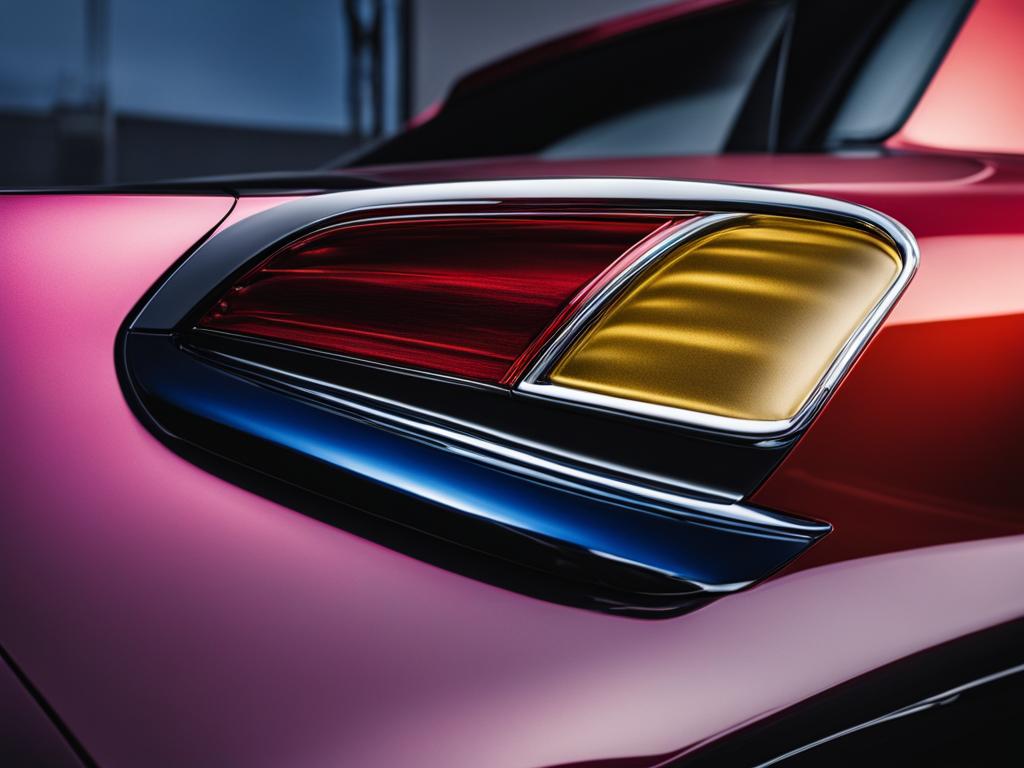
Paint Depth Measurements and Considerations
To ensure accurate paint correction and assess the quality of a paint job, professionals rely on car paint depth gauges to measure the thickness of each layer. By taking multiple measurements at different points on the vehicle’s surface, they can determine the combined thickness of the primer, base coat, and clear coat.
Measuring the paint thickness is essential for making informed decisions during the correction process. It allows professionals to minimize unnecessary clear coat removal and preserve the integrity of the paintwork. By understanding the depth of each layer, they can assess the overall paint job quality and address any irregularities or inconsistencies.
It is important to consider that paint depth can vary due to temperature-induced variations. Temperature changes can affect the thickness of the layers, making accurate measurements crucial for accurate correction.
Here is a sample table illustrating the recommended paint depth readings for each layer:
| Layer | Recommended Thickness (microns) |
|---|---|
| Phosphate Treatment | 5 |
| E-Coat | 20 |
| Primer | 20-30 |
| Base Coat | 13-38 |
| Clear Coat | 38-102 |
Take a look at the image below, which demonstrates a car paint depth gauge in action:
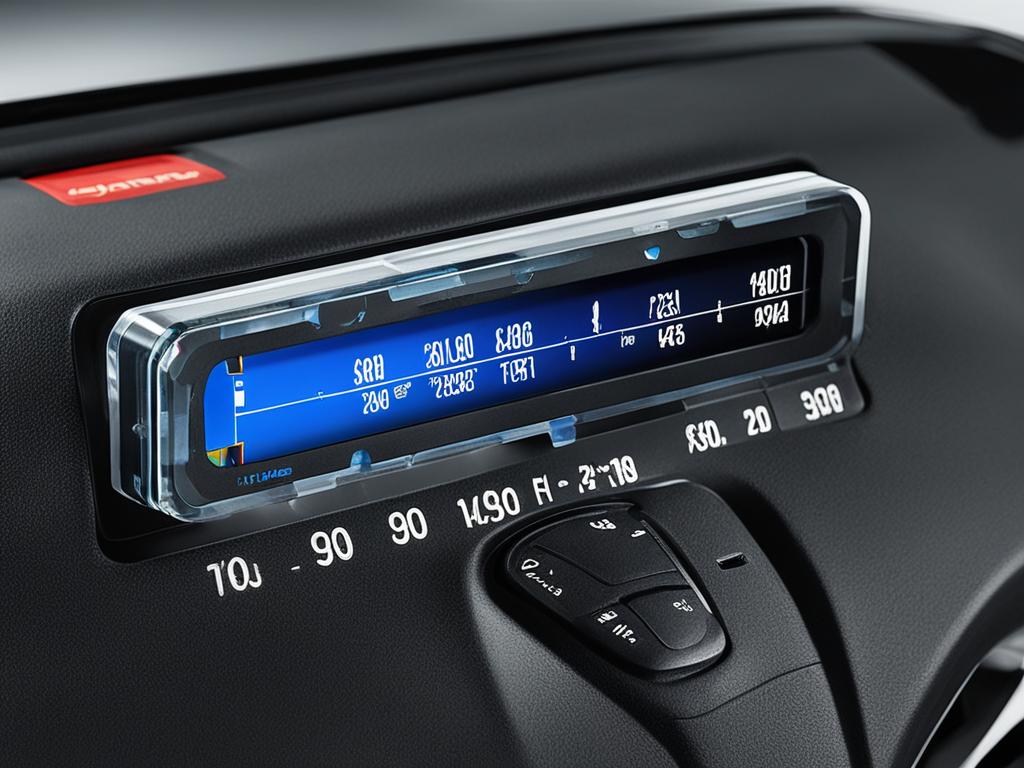
Accurately measuring the thickness of each paint layer is crucial for assessing the paint job quality and determining the available clear coat for correction. It allows professionals to make informed decisions, minimize clear coat removal, and preserve the integrity of the paintwork.
Implications of Paint Layers on Resprayed Vehicles
When analyzing paint layers, it is crucial to consider variations in total depth as an indication of a vehicle that has been resprayed. These variations can reveal interventions beyond the original paintwork, raising questions about the vehicle’s history and potential implications for its resale value and paint quality. Specifically, if the total depth of the paint layers exceeds the typical range of 67-198 microns (µm), it suggests that additional layers of paint have been applied.
An excess of paint thickness can have consequences for the vehicle’s original paint warranty. Respraying a car without following proper procedures or using substandard materials may lead to premature paint deterioration, reduced longevity, or even paint failure. The clear coat thickness and the composition of the UV protection system should also be given careful consideration when evaluating the impact of a vehicle respray.
Paint depth measurements are a valuable tool in identifying signs of a respray. By analyzing the paint layers’ thickness and composition, professionals can make appropriate recommendations concerning the vehicle’s paintwork and advise on potential issues related to resprayed car paint. This information helps car buyers and enthusiasts make informed decisions and ensures transparency and honesty in the automotive industry.
Respraying a vehicle is not necessarily a negative aspect, especially if done professionally and in adherence to industry standards. However, it is important to be aware of the indications of resprayed paint and to consider the potential implications on the vehicle’s overall condition and value.
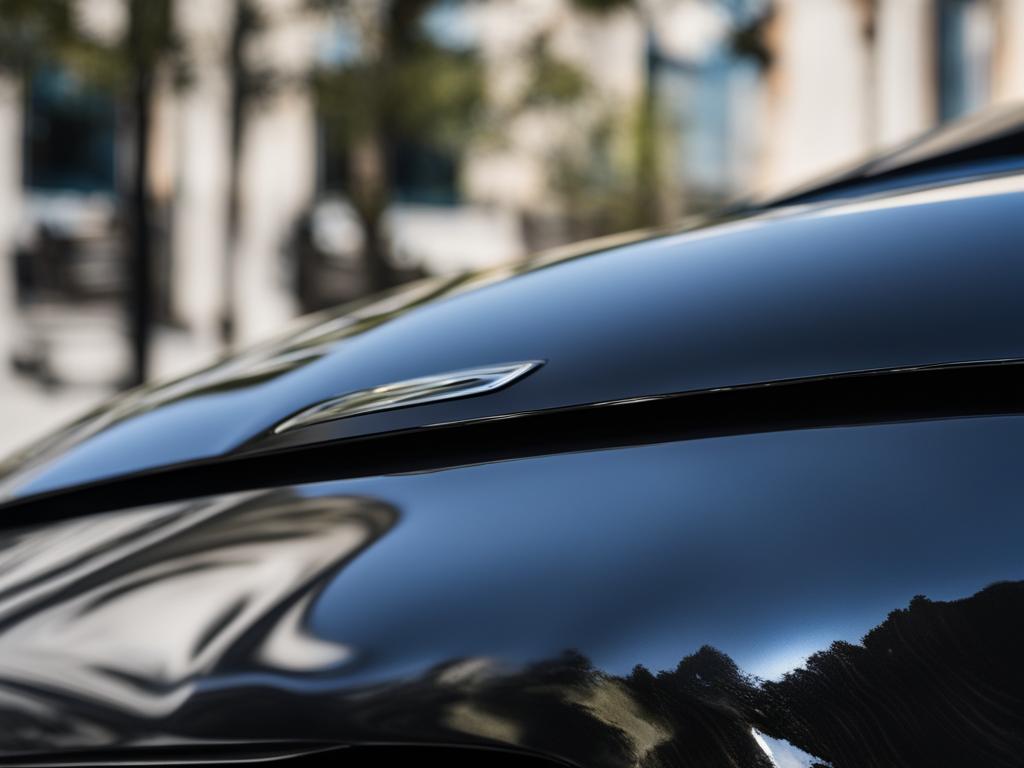
Recognizing Indications of Resprayed Paint
There are several indications that can help identify if a vehicle has been resprayed:
- Visual discrepancies in paint color or texture between panels
- Uneven paint thickness across the vehicle’s surface
- Paint overspray on moldings, trim, or adjacent surfaces
- Inconsistent paint reflection or glossiness
- Presence of paint tape lines or masking marks
- Irregular paint patterns or drips
Recognizing these indications can prompt further investigation or verification by a professional technician or paint expert, ensuring that the true condition of the vehicle’s paintwork is accurately assessed.
Proper evaluation of a vehicle’s paint layers and indications of resprayed paint is essential in maintaining transparency, trust, and consumer confidence in the automotive industry.
The Role of Car Paint Protection and Ceramic Coatings
Car paint protection is crucial in preserving the beauty and longevity of the paintwork. One highly popular option for car enthusiasts is ceramic coatings. These coatings provide a durable, scratch-resistant, and dirt-repellent layer that chemically bonds to the surface of the paint.
Ceramic coatings offer exceptional protection, making your car’s paintwork more resistant to the harsh effects of environmental factors and everyday wear and tear. With its water-repellent properties, ceramic coatings also make it easier to maintain a clean and shiny exterior.
By choosing the right car paint protection, such as ceramic coatings, you can significantly enhance the longevity and appearance of your vehicle’s paint job. These coatings not only provide an additional layer of defense against scratches and UV damage but also give your car a sleek and glossy finish that is sure to turn heads.
The Benefits of Car Paint Protection and Ceramic Coatings:
- Enhanced durability and scratch resistance
- Protection against UV damage and fading
- Repels dirt, grime, and water for easy cleaning
- Preserves the glossy finish of the paint
- Reduces the risk of paint chipping and peeling
- Prolongs the lifespan of the paintwork
“Investing in high-quality car paint protection, such as ceramic coatings, is like giving your vehicle a suit of armor. It shields your paintwork from the elements and daily driving hazards, ensuring that your car maintains its pristine appearance for years to come.” – Car Detailing Expert
If you want to protect your car’s paint and keep it looking its best, consider the long-lasting benefits that ceramic coatings provide. Alongside routine maintenance and proper washing techniques, a ceramic coating can significantly enhance the overall performance and aesthetics of your vehicle’s paintwork.

Conclusion
Understanding the depth and function of car paint layers is crucial for achieving optimal protection and aesthetics. Modern automotive paint systems consist of multiple layers that work in harmony to provide color, protection, and longevity. By considering the composition, thickness, and purpose of each layer, car owners can make informed decisions about paint care, correction, and protection. Giving proper attention to paint quality, measurements, and maintenance can help preserve the beauty and shine of a vehicle’s paintwork for years to come.
FAQ
What are car paint layers?
Car paint layers refer to the multiple layers of paint that are applied to a vehicle’s surface for protection and aesthetics.
How many layers are in a car paint system?
Most modern automotive paint systems consist of five layers: phosphate treatment, E-Coat, primer, base coat, and clear coat.
What is the purpose of automotive paint?
Automotive paint serves three essential functions: protecting the vehicle from corrosion and the elements, providing color, and promoting longevity with a glossy or matte finish.
How thick are car paint layers?
The total depth of car paint layers typically ranges between 67 and 198 microns (µm), with each layer contributing to the overall thickness.
How does paint correction affect clear coat thickness?
Paint correction, which involves removing blemishes and imperfections from a vehicle’s paintwork, primarily focuses on the clear coat. It is crucial to be mindful of the clear coat’s thickness and avoid removing more than 25% to preserve the paint warranty.
Why is paint quality important?
High-quality paint provides better protection against cracking, peeling, and inadequate protection. Regular maintenance through proper washing and waxing also plays a significant role in preserving the car’s paint job.
How do I choose the right automotive paint?
When selecting automotive paint, prioritize quality and consider factors such as durability, scratch resistance, and application methods. Consulting with experts and using ceramic sealants can ensure the highest levels of protection and scratch resistance for your vehicle’s paintwork.
What is paintwork density and hardness?
Paintwork density refers to the resistance to deformation, scratching, or penetration. Hardness, measured on the Mohs scale, indicates the paint’s resistance to scratching. Understanding paintwork density and hardness helps in selecting appropriate protection and care techniques.
How are paint depth measurements taken?
Professionals use paint depth gauges to assess paint depth. Multiple measurements are taken to determine the combined thickness of the primer, base coat, and clear coat. Paint depth measurements are crucial for paint correction and identifying signs of respraying.
How can I protect my car’s paint job?
Car paint protection is essential for maintaining the beauty and longevity of the paintwork. Ceramic coatings provide a durable, scratch-resistant, and dirt-repellent layer that chemically bonds to the paint’s surface, offering high levels of protection against environmental factors and everyday wear and tear.
What is the role of car paint layers?
Car paint layers provide protection, color, and longevity to a vehicle’s surface. Understanding the composition, function, and thickness of each layer is crucial for proper care, maintenance, and correction of automotive paint.



